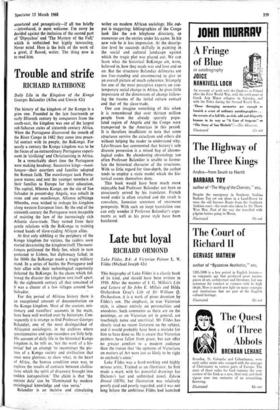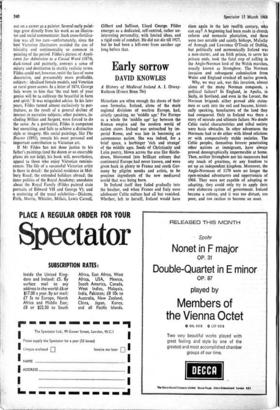Late but loyal
RICHARD ORMOND
Luke Fildes, RA: A Victorian Painter L. V. Fildes (Michael Joseph 42s) This biography of Luke Fildes is a classic book of its kind, and should have been written in 1910. After the manner of J. G. Millais's Life and Letters of Sir John E. Millais and Hilda Orchardson Gray's Life of Sir William Q. Orchardson, it is a work of pious devotion by Fildes's son. The emphasis, in true Victorian style, is almost entirely on personalities and anecdotes. Such comments as there are on the paintings, or on Victorian art in general, are touchingly naive and uncritical. Mr Fildes has clearly read no recent literature on the subject, and it would probably have been a mistake for him to have done so. He is aware that Victorian painters have fallen from grace, but can offer no greater comfort to a modern audience than the truism that `the opinions of Victorians on matters of Art were just as likely to be right as anybody's since.'
Luke Fildes was a hard-working and highly serious artist. Trained as an illustrator, he first made a mark with his powerful drawings for Dickens's last and unfinished novel, Edwin Drood (1870); but illustration was relatively poorly paid and poorly regarded, and it was not long before the ambitious Fildes had launched out on a career as a painter. Several early paint- ings grew directly from his work as an illustra- tor and social commentator. Such cross-fertilisa- tion was all too rare—unfortunately, since the best Victorian illustrators avoided the sins of triviality and sentimentality so common in painting of the period. Fildes's picture of Appli- cants for Admission to a Casual Ward (1874), dark-toned and painterly, conveys a sense of misery and destitution in starkly realistic terms. Fildes could not, however, resist the lure of more decorative, and presumably more profitable, subjects : idealised female models, and Venetian or rural genre scenes. In a letter of 1874, George Sala wrote to him that 'the real bent of your genius will be to cultivate the beautiful in form and spirit.' It was misguided advice. In his later years, Fildes turned almost exclusively to por- traiture, as the result of a general decline of interest in narrative subjects; other painters, in- cluding Millais and Sargent, were forced to do the same. As a portraitist, Fildes is competent but unexciting, and fails to achieve a distinctive style or imagery. His social paintings, like The Doctor (1891), remain his most personal and important contribution to Victorian art.
If Mr Fildes has not done justice to his father's paintings (and the dozen or so execrable plates do not help), his book will, nevertheless, appeal to those who enjoy Victorian reminis- cences. The life of a successful Victorian artist is there in detail: the palatial residence in Mel- bury Road; the extended holidays abroad; the inner politics of the Royal Academy; anecdotes about the Royal Family (Fildes painted state portraits of Edward VII and George V); and a scattering of the usual celebrities—Dickens, Frith, Morris, Whistler, Millais, Lewis Carroll, Gilbert and Sullivan, Lloyd George. Fildes emerges as a dedicated, self-centred, rather un- interesting personality, with limited ideas, and a rigid code of conduct. He did not die till 1927, but he had been a left-over from another age long before that.











































 Previous page
Previous page